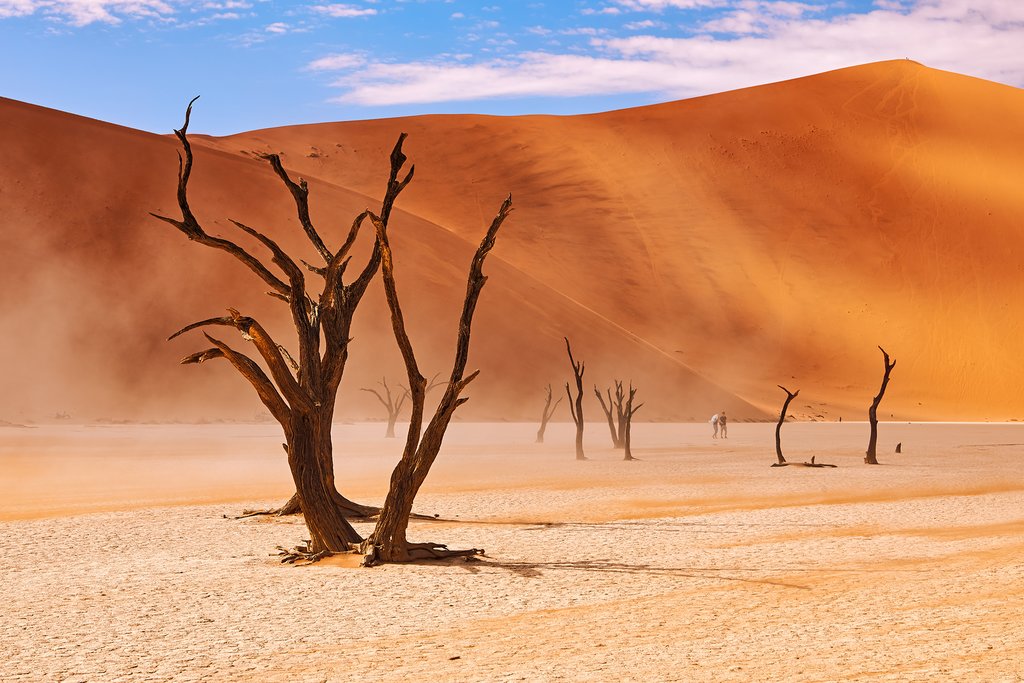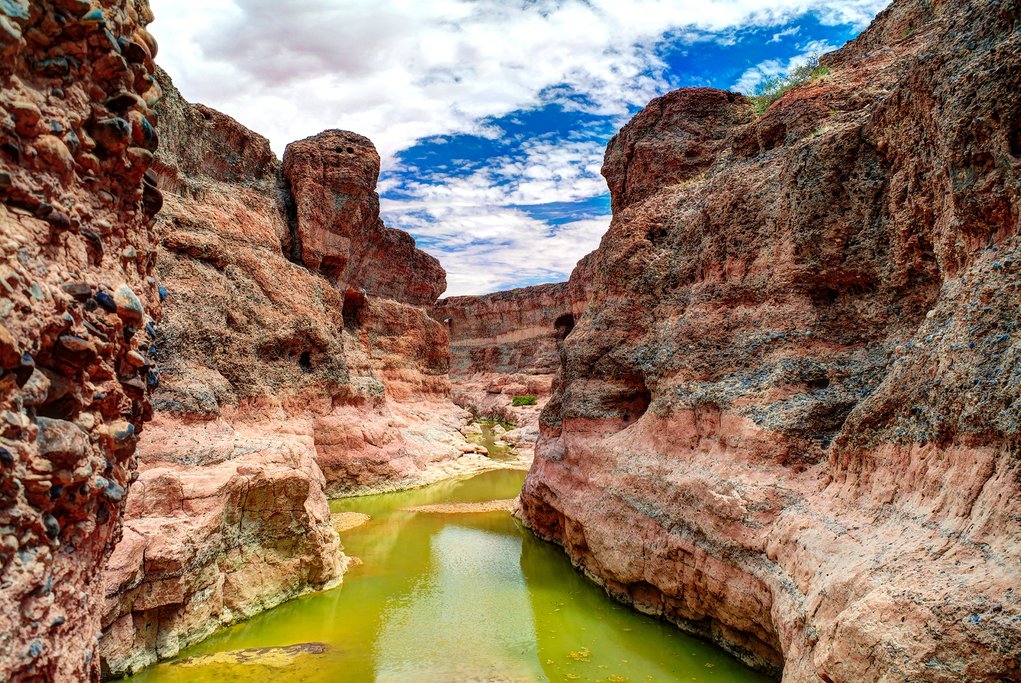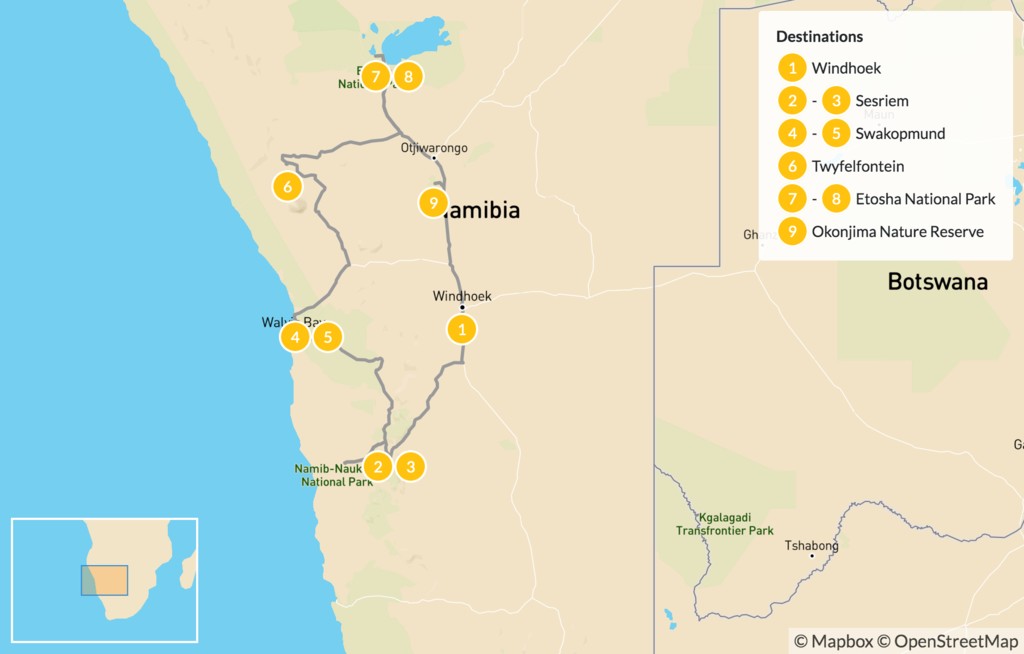Highlights
- Get up close to members of the Big Five as well as the highest peaks in Namibia
- Experience incredible landscapes in Sesriem Canyon and Sossusvlei Desert
- Chill out in two towns on the Atlantic coast (one with German colonial history)
- Discover Africa's largest concentration of petroglyphs at Twyfelfontein
- Spend two days exploring Namibia's largest wildlife sanctuary
Brief Itinerary
| Day | Highlights | Overnight |
|---|---|---|
| Day 1 | Arrive in Windhoek | Windhoek |
| Day 2 | Drive from Windhoek to the Namib Desert | Sesriem |
| Day 3 | Tour the Sossusvlei Desert | Sesriem |
| Day 4 | Drive from Sesriem to Swakopmund | Swakopmund |
| Day 5 | Explore Swakopmund & Walvis Bay | Swakopmund |
| Day 6 | Drive from Swakopmund to Twyfelfontein | Twyfelfontein |
| Day 7 | Drive from Twyfelfontein to Etosha National Park | Etosha National Park |
| Day 8 | Explore Etosha National Park | Etosha National Park |
| Day 9 | Drive from Etosha National Park to Okonjima Nature Reserve | Okonjima Nature Reserve |
| Day 10 | Okonjima to Windhoek, Depart |
Detailed Itinerary
Day 1: Arrive in Windhoek

Welcome to Namibia! Upon arrival at the Hosea Kutako International Airport, it's time to pick up a rental car and proceed to your hotel in the nation's capital—Windhoek—a great base to begin your road trip adventure. This tidy and modern city has a western flair that mixes nicely with the colors, sounds, and tempos of urban Africa.
If you have some daylight hours, learn about the end of apartheid at the Independence Memorial Museum, a free activity with a vast collection of paintings, displays, and artifacts that tell the story of the path to racial freedom. While here, you can visit the National Museum of Namibia, located next door in an old German fort dating back to the 19th century. Take some time to check out fascinating displays about Namibia's Indigenous San rock paintings.
Another great activity in Windhoek is the Namibia Craft Center, a clean and safe covered market with dozens of independent vendors selling the work of thousands of artists around the country. You'll find a range of items from African drums and woodcarvings, as well as elegant Swakara garments and Namibian gemstones. In addition to the stalls, there's also a bookstore, an art gallery, and a popular café that focuses on local ingredients for breakfast and lunch.
You can choose between cuisine options for dinner: Taiwanese, Italian, Portuguese, African, Chinese, French, and German.
Day 2: Drive from Windhoek to the Namib Desert

After breakfast in Windhoek, you'll begin the drive to the Namib Desert (211 miles/340 km), one of the oldest and largest deserts in the world. In fact, the Namib stretches far and wide, covering large swathes of land in Namibia and parts of South Africa and Angola. The distinct arid climate supports a diverse number of plants and animals, some of which are found nowhere else in the world.
Once you reach the desert, you'll be making your way to the Sesriem area, a small settlement close to the southern end of the Naukluft Mountains. Along the way, you'll drive over the Khomas Hochland highland region as you head west toward the great escarpment. You'll then descend this escarpment via Namibia's highest mountain pass, Spreetshoogte, to enter Sesriem in the central region of Namibia.
Day 3: Tour the Sossusvlei Desert

Today, you'll take part in an early morning excursion that travels along the path of the ancient Tsauchab River into the Namib Sand Sea. The adventure highlights the Sossusvlei Desert, including Dune 45 and Dead Vlei—all surrounded by red dunes in the southern part of the Namib Desert.
In fact, the word Sossusvlei is of Nama descent, which, directly translated, means "a place with many endings." Visitors who come to Namibia often say that this is the most stunning part of the desert, with monumentally high dunes (as high as 1,066 feet/325 m) and the shadows of their sinuous crests that continually change as the daylight waxes and wanes. The warm tints of the sand, ranging from pale apricot to brick orange and deep red, contrast vividly with the dazzling white surfaces of the deflationary clay pans at some of their bases.
In the afternoon, you'll have time to enjoy the landscapes and views around Sesriem Canyon, carved into the Tsauchab River over millions of years, resulting in a narrow gorge of just over a half-mile in length. At the foot of the gorge, which plunges over 100 feet (30 m), are pools that replenish after a good rain. Sesriem derives its name from the time when early pioneers tied six lengths of rawhide thongs ("Ses Rieme") together to draw water from these pools.
Following your excursion, return to your base in Sesriem for the night.
Day 4: Drive from Sesriem to Swakopmund

Today, you'll make the drive to Swakopmund (224 mi/360 km), a coastal city facing the Atlantic Ocean. As you depart the Namib Desert from Sesriem, continue north along the eastern boundary of Namib Naukluft Park. You'll then pass through the small settlement of Solitaire and onward via the Gaub and Kuiseb canyons. Continue across the gravel plains of the Namib Desert toward the country's largest coastal town, Swakopmund. If there's time, you may wish to travel to Swakopmund via the erosional feature of Moon Valley and see Namibia's ancient plant species, called the Welwitschia mirabilis, which is endemic to the Namib Desert.
Once you arrive in Swakopmund, take note of the German architecture. Known for its Old World charm and relaxed atmosphere, Swakopmund was founded in 1892 during the period of Namibia's German colonial rule, when it served as the territory's main harbor.
This is a popular destination for Namibians seeking respite from the heat of the interior of the country. Walk around and check out the town's beaches, walkways, and colonial landmarks, which include the Swakopmund Lighthouse and an old sea wall called the Mole. Next to the lighthouse is the Swakopmund Museum, where you can find documents on Namibian history. Meanwhile, the elegant Swakopmund Railway Station, now a hotel, also dates to the colonial era and is worth a look.
For food and drink, Swakopmund offers a good selection of restaurants and coffee shops that, no surprise, often include traditional German fare, cakes, and pastries.
Chat with a local specialist who can help organize your trip.
Day 5: Explore Swakopmund & Walvis Bay

Today, you'll have the entire day to explore Swakopmund, and another picturesque coastal town nearby called Walvis Bay at your own pace. Though Walvis Bay doesn't have the same charming German architecture as Swakopmund (thanks to the British occupation), you can find a new waterfront development, great food options, and beautiful sand dunes that jut up against the Atlantic.
You can also sign up for one of the unique experiences in the area, like the Dolphin Cruise, which sets sail from Walvis Bay Harbour. This is ideal for travelers who'd like to get up close to dolphins, as well as Cape fur seals and flamingo colonies. In addition, there are more desert day-trip excursions to choose from, like quad biking or dune boarding.
Day 6: Drive from Swakopmund to Twyfelfontein

This morning, it's best to make an early departure from Swakopmund as you make your way to Twyfelfontein (279 miles/449 km). You'll first head northbound through the National West Coast Recreational Area toward the small fishing town of Henties Bay. If you have time, make sure to stop in Cape Cross and say hello to the Cape fur seal colony here (this is also the place where the first European set foot on the coast of Namibia in 1486.)
Shortly after Henties Bay, continue east, crossing the gravel plains to the abandoned mining town of Uis. Continue north toward former Damaraland (now Erongo) in the Kunene Region. This route passes Brandberg Mountain, Namibia's highest at 8,442 feet (2,573 m), renowned for the famous tribal artworks, including The White Lady rock painting.
You'll eventually reach the UNESCO World Heritage site of Twyfelfontein, where you can visit one of the richest areas of rock engravings and San (Bushmen) tribes' paintings in Namibia, as well as the geological formations of the Burnt Mountain and the dolomite columns known as the Organ Pipes. Also of note in the area is the Doros Crater.
The flora and fauna of Damaraland include plants such as welwitschia, moringa, and a variety of Commiphora species, and animals such as the desert-adapted elephant, giraffe, springbok, oryx, and ostrich, which live in total harmony with the community and the communal farming activities of the Uibasen Twyfelfontein Conservancy. While here, you can join a guided nature drive in the dry Aba Huab riverbed, marvel at the rich vegetation, and possibly see the desert-adapted elephant.
Day 7: Drive from Twyfelfontein to Etosha National Park

This morning, you'll depart Twyfelfontein and make your way toward the renowned Etosha National Park (202 mi/325 km). Along the way, you can stop and walk around a protected petrified forest, with approximately 50 examples of petrified trees dating back some 260 million years.
In the afternoon, you'll arrive at your lodge situated just outside the park (meals included). Depending on what time you have lunch and get settled, there may be daylight hours left to get into the park and explore a bit with your guide and tour vehicle. Keep in mind that the park and its resorts' gates strictly open at sunrise and close at sunset.
Day 8: Explore Etosha National Park

After breakfast, you'll have the entire day to spend in Etosha National Park. Before you set out on your adventure, you'll consult with your guide and an animal sightings book to determine the current movement of animals in the area in order to optimize your game-viewing experience. Detailed maps of the park are also available at each resort curio shop and filling station.
Etosha National Park has over 114 mammal species, 350 bird species, and 21 types of vegetation. The most common plains game species encountered include Burchell's zebra, springbok, black-faced impala, blue wildebeest, gemsbok (South African oryx), giraffe, and red hartebeest. The park also boasts healthy populations of lions, elephants, and black rhinos.
In the heart of the park is the Etosha pan, meaning "place of dry water," an extensive flat depression of about 3,107 square feet (947 m). This great white expanse is a place of shimmering mirages; seeing large herds of game in this setting makes Etosha a unique experience in Africa.
Day 9: Drive from Etosha National Park to Okonjima Nature Reserve

After breakfast at your lodge outside Etosha National Park, you'll drive south to the Okonjima Private Game Reserve (144 mi/232 km). This beautiful area is at the heart of Namibia and is surrounded by the sandstone Omboroko Mountains. The landscape is home to an array of indigenous African wildlife and birds, which makes it the perfect place to take photos.
Upon arrival at Okonjima, enjoy a relaxing lunch and then pick between guided activities in the game reserve offered by your camp.
Day 10: Drive to Windhoek, Depart

It's time to say goodbye to Namibia! Depending on the time of our flight, you might have time to participate in an early morning activity at the reserve before making the return trip to Windhoek (161.5 mi/259 km).
The route passes through the small town of Okahandja, one of Namibia's oldest established settlements and also the administrative center of the Herero people. In fact, many of the former Herero leaders are buried here, and there's even an annual procession through town to their graves to commemorate those who died during the wars against the Nama and Germans. While here, consider a visit to the open-air woodcarving market and the Herero Grave Complex.
Then, continue the drive to Windhoek International Airport to return your rental car and catch your departure flight. Safe travels!
More Great Namibia Itineraries
Looking for more inspiration for your trip to Namibia? Check out these other Namibia itineraries, with outdoor adventures, wildlife safaris, and best-of tours to hit the highlights.


